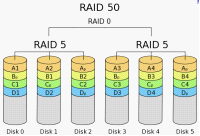Data Recovery -> RAID 30 And RAID 50
Storage devices
Types of HDD
Partition Series
Linux
Operating Systems
Windows
RAID 30 And RAID 50
RAID 30
RAID30 is also called Striping of Dedicated Parity Arrays which has features of RAID0 and RAID 3. It is an array composed of two RAID 3(each contains 3 disks) and has exclusive parity bit. And these two kinds of disks form a RAID 0 array, realizing crossing disk extraction of data. RAID provides Fault-Tolerant function and supports larger volumes. As RAID 10, RAID 30 also provides high reliability. Even two physical disks (one in each array) fail at the same time, the data is also available. In RAID 30, 6 drivers are needed at least. It is most suitable for non-interactive applications such as handling of video streaming, graphics and images. These application programs handle large files orderly and demand high reliability and speed.
RAID 50
 RAID 50 is called Striping of Distributed Parity Arrays. Similar as RAID 30, RAID 50 has features of both RAID 5 and RAID 0. It is composed of two groups of RAID 5(containing 3 disks at least in one group), and each group applies distributed parity bit. And these two kinds of disks form a RAID 0 array, realizing cross-disk extraction of data. RAID 50 provides reliable data storage and excellent overall performance and supports larger volumes. Even two physical disks (one in each array) fail at the same time; the data can also be recovered. In RAID 50, 6 drivers are needed at least. It is most suitable for applications which need high reliability storage, high read-write speed and high data transmission performance. These applications include transaction and office applications for small files access of many users.
RAID 50 is called Striping of Distributed Parity Arrays. Similar as RAID 30, RAID 50 has features of both RAID 5 and RAID 0. It is composed of two groups of RAID 5(containing 3 disks at least in one group), and each group applies distributed parity bit. And these two kinds of disks form a RAID 0 array, realizing cross-disk extraction of data. RAID 50 provides reliable data storage and excellent overall performance and supports larger volumes. Even two physical disks (one in each array) fail at the same time; the data can also be recovered. In RAID 50, 6 drivers are needed at least. It is most suitable for applications which need high reliability storage, high read-write speed and high data transmission performance. These applications include transaction and office applications for small files access of many users.
RAID30 is also called Striping of Dedicated Parity Arrays which has features of RAID0 and RAID 3. It is an array composed of two RAID 3(each contains 3 disks) and has exclusive parity bit. And these two kinds of disks form a RAID 0 array, realizing crossing disk extraction of data. RAID provides Fault-Tolerant function and supports larger volumes. As RAID 10, RAID 30 also provides high reliability. Even two physical disks (one in each array) fail at the same time, the data is also available. In RAID 30, 6 drivers are needed at least. It is most suitable for non-interactive applications such as handling of video streaming, graphics and images. These application programs handle large files orderly and demand high reliability and speed.
RAID 50
 RAID 50 is called Striping of Distributed Parity Arrays. Similar as RAID 30, RAID 50 has features of both RAID 5 and RAID 0. It is composed of two groups of RAID 5(containing 3 disks at least in one group), and each group applies distributed parity bit. And these two kinds of disks form a RAID 0 array, realizing cross-disk extraction of data. RAID 50 provides reliable data storage and excellent overall performance and supports larger volumes. Even two physical disks (one in each array) fail at the same time; the data can also be recovered. In RAID 50, 6 drivers are needed at least. It is most suitable for applications which need high reliability storage, high read-write speed and high data transmission performance. These applications include transaction and office applications for small files access of many users.
RAID 50 is called Striping of Distributed Parity Arrays. Similar as RAID 30, RAID 50 has features of both RAID 5 and RAID 0. It is composed of two groups of RAID 5(containing 3 disks at least in one group), and each group applies distributed parity bit. And these two kinds of disks form a RAID 0 array, realizing cross-disk extraction of data. RAID 50 provides reliable data storage and excellent overall performance and supports larger volumes. Even two physical disks (one in each array) fail at the same time; the data can also be recovered. In RAID 50, 6 drivers are needed at least. It is most suitable for applications which need high reliability storage, high read-write speed and high data transmission performance. These applications include transaction and office applications for small files access of many users.